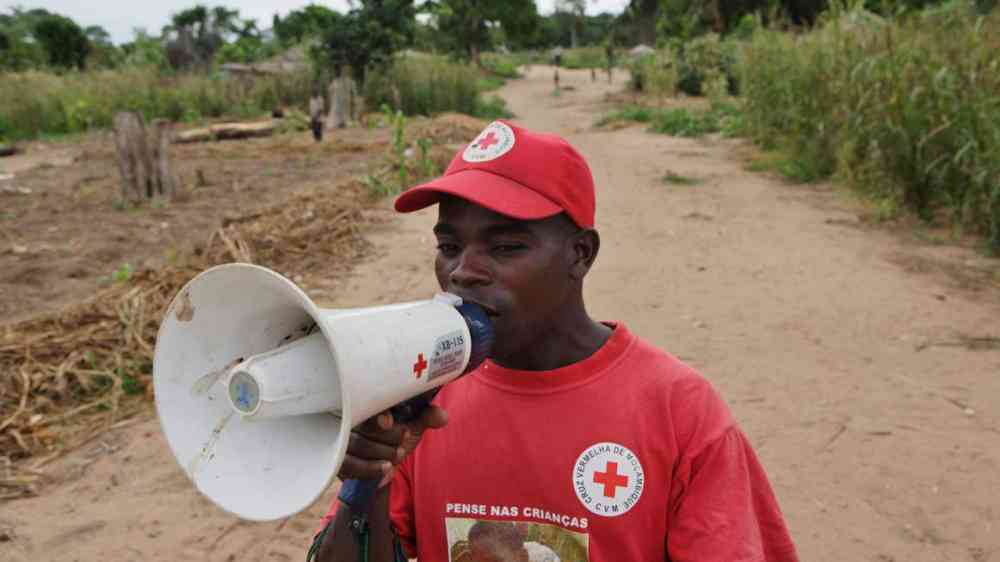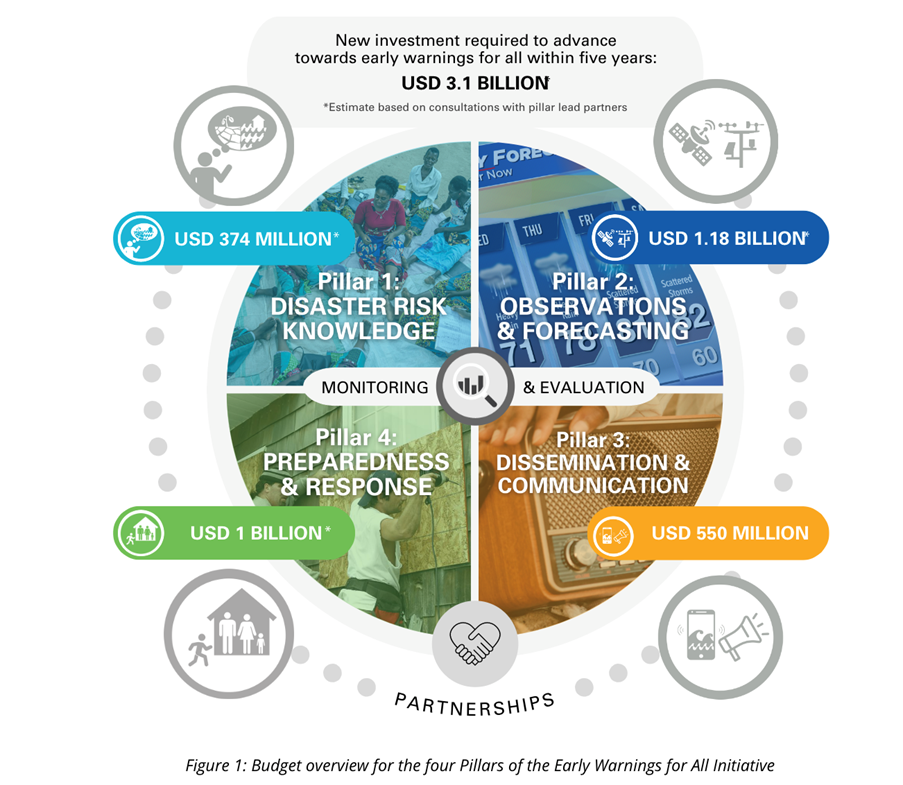Early Warnings for All Action Plan unveiled at COP27

Initial five year investment cost is estimated at US$ 3.1 billion, benefits are huge.
Sharm el-Sheikh, Egypt, 7 November 2022 (WMO) - It will cost the equivalent of just 50 cents per person per year for the next five years to reach everyone on Earth with early warnings against increasingly extreme and dangerous weather, according to a plan unveiled today by United Nations Secretary-General António Guterres.
The Executive Action Plan for the Early Warnings for All initiative calls for initial new targeted investments between 2023 and 2027 of US$ 3.1 billion – a sum which would be dwarfed by the benefits. This is a small fraction (about 6 percent) of the requested US$ 50 billion in adaptation financing. It would cover disaster risk knowledge, observations and forecasting, preparedness and response, and communication of early warnings.
Mr Guterres announced the plan at a meeting of government and UN organization leaders, financing agencies, Big Tech companies and the private sector during the World Leaders Summit at the UN climate change negotiations, COP27. The plan was drawn up by the World Meteorological Organization and partners, and it was supported by a joint statement signed by 50 countries.
“Ever-rising greenhouse gas emissions are supercharging extreme weather events across the planet. These increasing calamities cost lives and hundreds of billions of dollars in loss and damage. Three times more people are displaced by climate disasters than war. Half of humanity is already in the danger zone,” said Mr Guterres.
“We must invest equally in adaptation and resilience. That includes the information that allows us to anticipate storms, heatwaves, floods and droughts. To that end, I have called for every person on Earth to be protected by early warning systems within five years, with the priority to support the most vulnerable first,” said Mr Guterres.
The Executive Action Plan sets out the concrete way forward to achieve this goal.
The need is urgent. The number of recorded disasters has increased by a factor of five, driven in part by human-induced climate change and more extreme weather. This trend is expected to continue.
And yet, half of countries globally do not have early warning systems and even fewer have regulatory frameworks to link early warnings to emergency plans. Coverage is worst for developing countries on the front lines of climate change, namely Least Developed Countries (LDCs) and Small Island Developing States (SIDS).
Scientific advances
Early warning systems are widely regarded as the “low-hanging fruit” for climate change adaptation because they are a relatively cheap and effective way of protecting people and assets from hazards, including storms, floods, heatwaves and tsunamis to name a few.
“Early warnings save lives and provide vast economic benefits. Just 24 hours notice of an impending hazardous event can cut the ensuing damage by 30 per cent,” said WMO Secretary-General Prof. Petteri Taalas.
The Global Commission on Adaptation found that spending just US$800 million on such systems in developing countries would avoid losses of $3 to 16 billion per year.
“Such progress is only possible with modern science, sustained systematic observing networks, daily international exchange of quality data, access to high-quality early warning products, the translation of forecasts into impacts, plus advances in telecommunications,” said Prof. Taalas.
The essential ingredients to achieve Early Warnings for All include: deeper understanding of risk across all time scales; stronger national meteorological and hydrological services, disaster risk management agencies and emergency preparedness measures; accessible financial and technical support and an anticipatory humanitarian sector. A people-centred approach that prioritizes community engagement is fundamental.
The Executive Action plan 2023-2027 sets out the recipe for how these ingredients can come together to achieve that goal. It summarizes the initial actions required to achieve the goal, and sets out the pathway to implementation.
Sameh Hassan Shoukry, Egyptian Minister of Foreign Affairs and COP27 President, said : “The science is there and clearly shows the urgency with which we must act to assist those in need of support to adapt to the negative impacts of climate change. The launch of this Executive Action Plan is an important contribution for adaptation and resilience, particularly in Africa, where 60 percent of people are not covered by early warning systems.”
The President of Mozambique, Filipe Jacinto Nyusi, and a number of prime ministers and ministers spoke at the high-level round table to launch the Early Warnings for All action plan, underlining the widespread political support for the initiative.
Brad Smith, Vice Chair and President of Microsoft, addressed the event - highlighting the fundamental role that technology can play in ensuring that early warnings reach the last mile.
“This UN initiative will save lives by enabling people to adapt to climate change and respond to early warnings before disaster strikes,” said Mr Smith. “We have the AI and data tools today. Let's put them to work to predict and warn of the next crisis.”
« The Early Warnings for All initiative offers an opportunity for countries to significantly increase their understanding of risk, which is the foundation for all resilience-building efforts. For these reasons and more, implementing this Action Plan is critical to saving lives. Secretary-General Guterres provided us with the vision and WMO has provided us with ‘the how.’ It is up to us all now to make this a reality,” said Mami Mizutori, Special Representative of the Secretary-General for Disaster Risk Reduction and head of the UN Office for Disaster Risk Reduction.
Other speakers at the round table on the opening day of COP27 included the heads of the UN Framework for Climate Change, the Green Climate Fund, Adaptation Fund, Climate Investment Funds and Islamic Development Bank, World Food Programme, the International Federation of Red Cross and Red Crescent.
Four pillars

The estimated new targeted investments of US$ 3.1 Billion over the five years would be used to advance the four key Multi-Hazard Early Warning System (MHEWS) pillars:
- Disaster risk knowledge (US$374 million) - systematically collect data and undertake risk assessments on hazards and vulnerabilities
- Observations and Forecasting (US$1.18 billion) - develop hazard monitoring and early warning services
- Preparedness and response ($1 billion) - build national and community response capabilities
- Dissemination and communication (US$ 550 million) - communicate risk information so it reaches all those who need it, and is understandable and usable
The plan identifies key areas for advancing universal disaster risk knowledge, and outlines the priority actions required to achieve this, building on the Sendai Framework for Disaster Risk Reduction.
It prioritizes the top technical actions required to enhance capacity to detect hazards, close the observations gap, and advance global forecast data processing systems and data exchange, optimizing international efforts.
The plan indicates how key foundational financing mechanisms will be scaled up to support the achievement of the goal, including a new framework developed by the Climate Risk and Early WarningSystems (CREWS) Initiative and Green Climate Fund, and the operationalization of the Systematic Observations Financing Facility (SOFF).
The plan also calls for increased coherence and alignment of existing and planned investments from international financing institutions, utilizing the Alliance for Hydromet Development as an important uniting partnership of climate finance institutions.
The plan recognizes existing successful bilateral funds for early warnings and calls for an acceleration of these mechanisms. Tracking progress, informing decision making, and measuring success are all key to ensuring effective implementation, and so plans are outlined to develop an objective Early Warnings for All Maturity Index in advance of COP 28.
To ensure progress and the continued strategic alignment of activities with implementing bodies, the United Nations Secretary-General is creating an Early Warnings for All Governing Board, co-chaired by the Executive Heads of the World Meteorological Organization (WMO) and the United Nations Office for Disaster Risk Reduction (UNDRR).
Board membership will include many of the key partners who have shaped this Executive Action Plan to date. The Board will report annually onprogress to the United Nations Secretary-General in advance of the COP meetings.
In addition, an annual Multi-Stakeholder Forum will be organized to enhance consultation and foster collaboration with a wider group of partners.